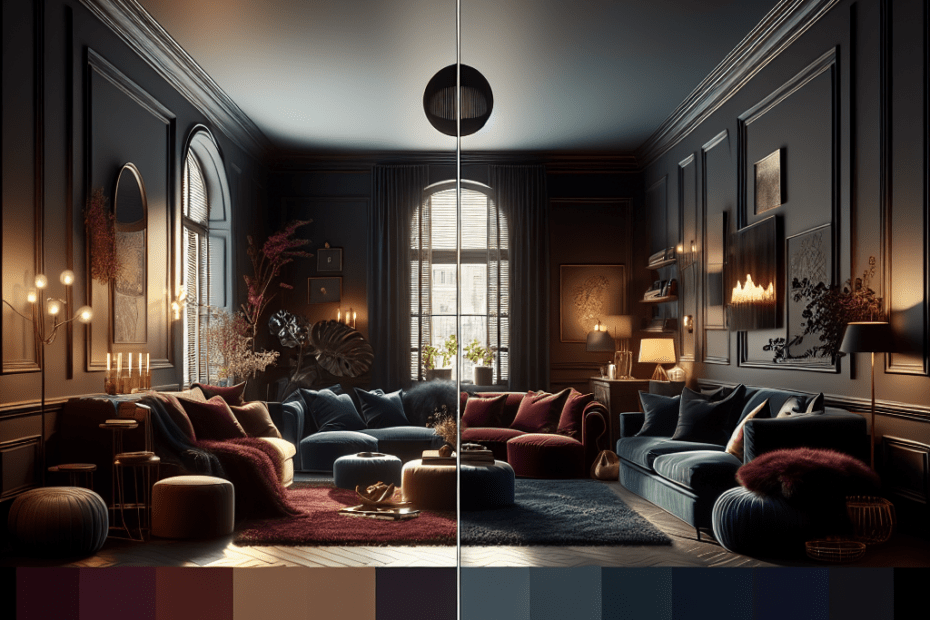“`html
Creating a Cozy, Intimate Space with Dark Colors in Design
When people think of creating a cozy and intimate space, they often imagine light, pastel colors or muted tones. Instead, they could consider using dark colors to bring warmth and snugness. It’s no secret that dark colors in design can evoke feelings of comfort and closeness, but how do they achieve this effect? In this article, they will explore how dark colors can be used to design a welcoming space, the best hues to choose, and some design tips from experts.
The Power of Dark Colors
Dark colors can warm up a space by wrapping it with an enveloping feel, just like a cozy blanket on a winter evening. When they use deep hues like navy blue, charcoal gray, and forest green, they can make a room feel more intimate and sophisticated. These colors absorb light, making spaces feel smaller but more inviting at the same time. According to a survey by Statista, 45% of interior designers use dark colors to create a cozy environment (source: Statista).
Choosing the Right Dark Colors
When they choose dark colors, they need to consider the overall theme and mood they want to set. Here’s a look at some popular dark colors and what they signify in design:
| Color | Meaning |
|---|---|
| Navy Blue | Calm, stable, and sophisticated |
| Charcoal Gray | Moody, neutral, and chic |
| Forest Green | Balanced, refreshing, and natural |
| Deep Burgundy | Luxurious, warm, and rich |
| Dark Chocolate | Earthy, inviting, and grounded |
Navy blue and forest green are popular choices for walls, while charcoal gray and deep burgundy can also work as accent colors or for specific focal points within a room. Dark chocolate tones add an earthiness that can help anchor a space.
Tips for Incorporating Dark Colors
Some might worry about a room feeling too gloomy with dark colors, but with the right approach, they can create a perfect balance. Here are some tips to keep in mind:
- Consider the lighting: Dark colors work best in rooms with good natural light. If the space lacks sunlight, they should add sufficient artificial lighting.
- Use lighter accents: While dark hues create the main backdrop, lighter elements such as cushions, throws, or trims can add contrast and brightness.
- Layer textures: They should incorporate various textures such as velvet, wool, or wood in their design to add depth and interest.
- Strategic placement: Dark colors can recede a wall or bring a piece of furniture into focus. They should think about where they want eyes to draw in the room.
Benefits of Dark Colors in Design
They often underestimate the psychological and physiological effects of dark colors. Studies have shown that colors can influence mood and perception. According to a report from the American Psychological Association, colors like blue and green can lower blood pressure and heart rates (source: APA). This makes dark colors a soothing choice for spaces meant for relaxation and unwinding.
Moreover, dark colors can enhance the sense of privacy and security. It can be especially beneficial in bedrooms or reading nooks where they want to wind down after a long day.
Expert Insights
Leading interior designers echo these benefits, suggesting that dark colors in design bring a touch of sophistication and timeless elegance. Design guru Nate Berkus once noted, “Dark colors work because they create a strong, definitive backdrop that’s both bold and serene.”
Key Takeaways
- Dark colors can create a cozy, intimate, and inviting atmosphere.
- Choosing the right dark hues involves understanding their meaning and mood-setting potential.
- Effective design with dark colors requires careful attention to lighting, texture, and balance.
- Dark colors can enhance privacy and have calming effects, making them suitable for relaxation spaces.
Frequently Asked Questions (FAQ)
- Can dark colors make a small room look cramped?
Dark colors can make a room feel more intimate, but by using mirrors and strategic lighting, they can prevent it from feeling cramped.
- What are some good dark color combinations?
Navy blue with soft yellow, charcoal gray with blush pink, and forest green with gold are a few stylish combinations.
- Are there any specific rooms that benefit from dark colors?
Bedrooms and living rooms are ideal for dark colors as they support relaxation and coziness.
- How can they introduce dark colors without repainting a room?
They can incorporate dark-colored furniture, curtains, or accents like vases and artwork.
- Do dark colors suit modern and traditional design styles?
Yes, dark colors can complement both modern and traditional styles by pulling elements together in a cohesive manner.
“`
Dark colors in design offer endless possibilities to personalize a space, making it warm, inviting, and stylishly captivating. Through thoughtful choices and creative accents, they can transform any room into a retreat where comfort meets elegance.
